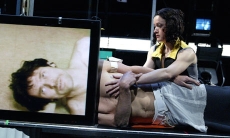 In a recent thought-provoking Createquity post, Creative Placemaking Has an Outcomes Problem, Ian David Moss examines one of the newer initiatives of the NEA (and its private philanthropy friends) and finds it to be lacking a logic for how it will achieve its aims. Moss criticizes this program and others for attempting to connect the arts with economic development without considering the steps in between. Moss’s post is a call for a clear and detailed theory of change for such initiatives and he goes so far as to share two models (one simple and one quite complex) that he has developed.
In a recent thought-provoking Createquity post, Creative Placemaking Has an Outcomes Problem, Ian David Moss examines one of the newer initiatives of the NEA (and its private philanthropy friends) and finds it to be lacking a logic for how it will achieve its aims. Moss criticizes this program and others for attempting to connect the arts with economic development without considering the steps in between. Moss’s post is a call for a clear and detailed theory of change for such initiatives and he goes so far as to share two models (one simple and one quite complex) that he has developed.
When I read Moss’s essay, I immediately thought of the questionable motives and unquestioned assumptions that seem to underpin many philanthropic efforts in the arts. (I thought about saying “these days†at the end of that last sentence but, to be honest, I’m not sure whether it’s ever been any different.) To the best of my knowledge, the king of arts funding, Mac Lowry at the Ford Foundation, didn’t develop a sophisticated framework or a complex theory of change when he set about altering the landscape of the arts in America. (Of course some might suggest that the arts sector would be better off now if he had.)
Moss’s models and theories are impressive (and I am quite eager to see how the work in Cincinnati develops over time); but I suspect that many arts funders would see no reason and feel no pressure to go to such lengths. There are few demands that private foundations justify their strategies and they are rarely, if ever, held accountable for poor decisions. We trust funders, perhaps to a fault. Or perhaps it’s not trust as much as behavioral conditioning. Or enlightened self interest.
While Moss is (rightfully) worried that arts funders are failing to connect the dots between their grantmaking and the goals they are aiming to achieve, I must admit that I get a little nervous when I think about some funders trying to work with logic models like the ones in Moss’s post. I scan various philanthropy announcements each week. Aside from noting the incredible number of very large donations made to universities, lately I’m often struck by how paternalistic, prescriptive, demanding, inflexible, and self-congratulatory arts funding has become.
(Or has it always been this way and I’m just getting cranky with age?)
I am concerned that arts funders are becoming ever more bullish and confident that they know what’s best for the sector. A little bit of theory and systems thinking may be worse than none at all. I worry that dabbling with or employing such models could make funders all the more convinced that they can (and should) strengthen or improve or otherwise re-shape the entire arts sector by making a few dozen grants a year. I worry that funders will blame grantees if their models don’t work. More than anything, I worry about how funders may begin to connect the dots.
POSTSCRIPT ADDED JUNE 1 2012: Here’s a link to some reflections from Jason Schupbach, NEA Director of Design in response to Ian David Moss’s post on Creative Placemaking: Creative Placemaking—two years and counting!







